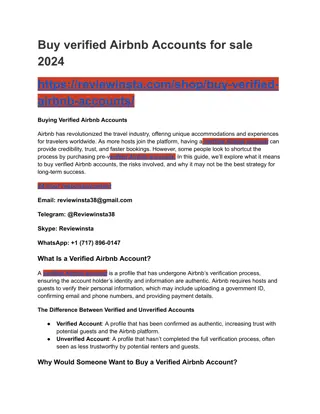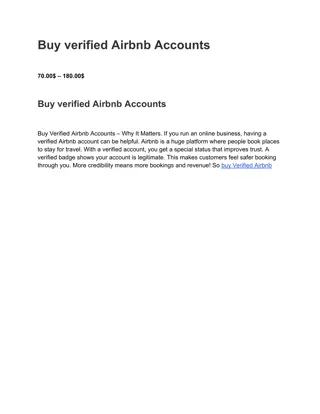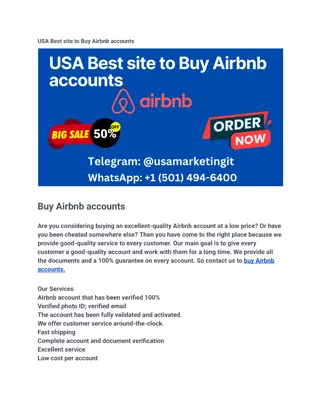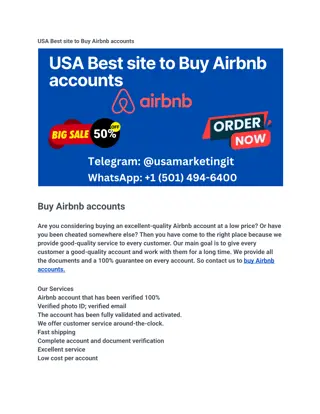
Short-Term Rental Regulations and Challenges Faced by Homestay Companies
Discover the regulations and challenges surrounding short-term rentals with homestay companies like AirBnB. Learn how technology has influenced these companies and how municipalities are regulating the commercial use of short-term rentals in residential areas.
Download Presentation

Please find below an Image/Link to download the presentation.
The content on the website is provided AS IS for your information and personal use only. It may not be sold, licensed, or shared on other websites without obtaining consent from the author. If you encounter any issues during the download, it is possible that the publisher has removed the file from their server.
You are allowed to download the files provided on this website for personal or commercial use, subject to the condition that they are used lawfully. All files are the property of their respective owners.
The content on the website is provided AS IS for your information and personal use only. It may not be sold, licensed, or shared on other websites without obtaining consent from the author.
E N D
Presentation Transcript
The Law Offices of Mark A. Cuthbertson 434 New York Avenue Huntington, NY 11743 www.cuthbertsonlaw.com Tel: (631) 351-3501 Fax: (631) 427-9507
Homestay Companies: A Guide To Short-Term Rental Regulations Suffolk County Village Officials Association Municipal Training
A Guide To Short-Term Rental Regulations Background
A Guide To Short-Term Rental Regulations Technology Brings Change Technology companies have revolutionized modern society. Amazon created a paradigm shift in how people shop. Google has become so ubiquitous, its very name is a verb meaning to search. The common thread is that tech companies challenge the status quo, and while consumers may ultimately benefit from their actions, these disruptive forces inevitably create problems for society at large. This presentation concerns homestay companies like AirBnB, with a focus on the challenges these companies pose, and how municipalities have attempted to regulate these short-term rentals, a commercial use, in residential dwellings.
A Guide To Short-Term Rental Regulations Homestay Companies How They Work Most homestay companies follow the AirBnB model, where hosts rent to guests by listing their accommodations on AirBnB s website or mobile application. These accommodations can range from a couch in an apartment to an entire single- family home. The length of stays is similarly flexible, and can be arranged on anything from a nightly to a monthly basis. As to cost, hosts set their own prices for each rental. Homestay companies then take a percentage fee from both the guest and the host for each rental booked.
A Guide To Short-Term Rental Regulations Homestay Companies How They Work Homestay companies also provide several safety features. For example, AirBnB requires background checks on both hosts and guests, identity verification using government-issued ID, the use of secure payment services, and provides its own secondary insurance (with hosts required to carry their own primary insurance). AirBnB also includes a logged private messaging system so that hosts can correspond with potential guests. Hosts may also decline or cancel reservations, subject to reasonable limitations such as anti-discrimination laws.
A Guide To Short-Term Rental Regulations How Widespread Are Homestay Companies? As of March 2017, AirBnB is valued at approximately $31 billion, having attained profitability after revenue jumped more than 80% from 2015 to 2016. The company boasts over 3 million listings spanning 65,000 cities in 191 countries. It also claims to have 150 million registered users globally, and it maintains offices in 20 cities around the world. There are also numerous smaller homestay companies, such as VRBO, HomeAway, BeWelcome, and CouchSurfing, that provide similar services.
A Guide To Short-Term Rental Regulations Homestay Companies On Long Island In 2016, AirBnB reported that nearly 2 million guests stayed with 48,600 hosts in New York State alone. This included approximately 74,000 guests on Long Island, which represented an increase of 57.4% year-over-year, and 229% since 2014. In certain areas, the growth was even more pronounced. For example, the number of guests in or around Jones Beach spiked over 500%.
A Guide To Short-Term Rental Regulations Homestay Companies On Long Island The number of hosts on Long Island also rose in 2016, growing from 1,500 in to 2,400. Overall, Long Island AirBnB hosts generated approximately $25 million in revenue, with the median host having an income of $9,800. Notably, AirBnB officials have testified before several Town Boards that the vast majority of its hosts only rent their homes or apartments on a part-time basis, rather than operating a full-time commercial enterprise.
A Guide To Short-Term Rental Regulations Benefits and Criticisms
A Guide To Short-Term Rental Regulations Benefits and Criticisms - Introduction As discussed in the following slides, homestay companies have faced criticism on several fronts, particularly at the local level. Yet AirBnB s rapid growth despite this pushback, both on Long Island and globally, shows that demand for its services remains high, and that its users are largely content with how it operates. Thus, before examining possible regulatory approaches to short-term rentals, it is important to understand both the benefits and drawbacks of homestay companies and the explosion in the number of short-term rentals that they have created.
A Guide To Short-Term Rental Regulations Benefits For Hosts For hosts, AirBnB provides a significant supplemental source of income. As noted earlier, the median income for AirBnB hosts on Long Island in 2016 was $9,800. These funds can be used to offset Long Island s high cost of living by helping to pay the property s mortgage, property taxes, or to fund home renovations. Some hosts also rent socially, using AirBnB as a medium for meeting new people with a variety of backgrounds.
A Guide To Short-Term Rental Regulations Benefits For Guests For guests, AirBnB provides an alternative to traditional hotels that can better fit a guest s individual needs. While some guests may seek accommodations that are cheaper or more conveniently located than a hotel, others may place more value on the accommodation s quality or the feel of a given neighborhood. Ultimately, guests benefit because homestay companies provide greater flexibility than hotels, while simultaneously providing security measures that make renting simple and safe for all involved.
A Guide To Short-Term Rental Regulations Criticisms Quality Of Life Though favored by its users, AirBnB has also come under fire for the negative impacts associated with short-term rentals. Such criticisms are often made by local officials and civic associations concerned about the impact, whether real or perceived, that short-term rentals have on the character of the neighborhood. Common complaints include excessive noise (both day and night), large gatherings, reduced parking, and other impacts adversely affecting quality of life.
A Guide To Short-Term Rental Regulations Criticisms Quality Of Life An example of this is Lido Beach, where residents testified before the Hempstead Town Board that AirBnB had created unsafe party houses near their beachfront homes. Similarly, in the Town of Islip, residents testified that AirBnB has resulted in car overcrowding, loud music and noise from parties well into the late-night hours. Though supporters claim that these incidents represent a few bad actors, these impacts have nonetheless upset local residents, who are concerned that the peace and quiet of their neighborhood is being disturbed.
A Guide To Short-Term Rental Regulations Criticisms Housing Concerns Critics have also alleged that homestay companies adversely impact housing, citing investors that buy multiple homes or apartments for use as short-term rentals on a full-time basis. As a result, critics argue that homestay companies contribute to housing shortages and rising costs, particularly in cities like New York and Austin where residents are being priced out of their neighborhoods and affordable rental housing is already in short supply. Municipalities also object to allowing full-time commercial uses in residential neighborhoods.
A Guide To Short-Term Rental Regulations Criticisms Accountability Finally, investor-owners of short-term rental properties, who are largely absentee owners, are often criticized as being unaccountable to the neighbors and communities where the rentals are located. Critics claim that the absence of these owners amplifies the adverse quality of life impacts discussed above, arguing that such impacts might be prevented if a host was present to oversee guests and respond to neighbor complaints.
A Guide To Short-Term Rental Regulations The Need For Regulation Given the sheer size and scope of homestay companies like AirBnB, there is little doubt that the short-term rental market will continue to grow. However, the criticism from local residents is driving many municipalities to reexamine their short-term rental laws in light of the challenges that homestay companies pose. The hope is that with thoughtful regulation, users can continue to reap the benefits of AirBnB, while mitigating any associated negative impacts.
A Guide To Short-Term Rental Regulations Areas Of Potential Municipal Regulation
A Guide To Short-Term Rental Regulations Regulatory Issue Overview Regardless of whether proposed regulations for short-term rentals (i.e. rentals for a period of less than 30 days) are being considered at the Town or Village level, there are numerous options available. These possibilities range from an absolute prohibition on short-term rentals, to doing nothing and leaving such rentals totally unregulated. However, many municipalities will opt for a middle ground, in which short term rentals are permitted subject to limited regulation.
A Guide To Short-Term Rental Regulations Regulatory Issue Overview With respect to regulation, there are several issues that deserve particular attention. These are: (1) Whether Rentals Must Be Owner-Occupied; (2) Individual And/Or Aggregate Limits On Rental Duration; (3) Whether To Require Rental Permits; (4) Qualify Of Life Regulations; and (5) Penalties And Procedures For Violations.
A Guide To Short-Term Rental Regulations Owner-Occupied Dwellings One facet of regulations that is often considered is whether to require that the rental be part of an owner-occupied dwelling (i.e. that the owner resides there as his primary residence). This serves two purposes. First, requiring that the owner be living in the primary dwelling creates a level of accountability, as he or she will be present to observe the guests behavior and can respond to complaints from authorities or neighbors if prohibited or disruptive conduct is occurring.
A Guide To Short-Term Rental Regulations Owner-Occupied Dwellings Second, an owner-occupancy requirement serves to limit the ability of individuals to purchase multiple properties for use as short-term rentals, a direct response to some of the criticisms noted above about the impact short-term rentals have on the housing prices and availability. This also helps to limit the total number of short-term rentals.
A Guide To Short-Term Rental Regulations Limits on Rental Duration Another potential regulation is to place durational limits on short-term rentals. This can include caps on the length of individual rental, limits on the number of consecutive days a dwelling may be rented out, or aggregate limits on how many days per month or year that the dwelling may be used as a short-term rental. Such regulations are closely tied to owner-occupation requirements, in that they seek to prevent absentee owners or housing issues. In essence, durational limits allow municipalities to prevent the conversion of residential units to full-time commercial use, while still allowing homestay companies to operate in the area.
A Guide To Short-Term Rental Regulations Permitting Requirements - Overview A third consideration for municipalities seeking to regulate short-term rentals is whether to impose permitting requirements, and the conditions for obtaining and renewing such permits. Permit requirements can include application fees, providing the municipality with information about the property and its owner, insurance requirements, and so forth. This helps ensure that minimum standards for health and safety in short term rentals are being met.
A Guide To Short-Term Rental Regulations Permitting Requirements - Overview Permits can also provide municipalities with a powerful tool to compel compliance with short-term rental regulations, as the issuance and retention of rental permits can be conditioned on the host s compliance with regulations on quality of life issues. Permits are a commonly used tool, albeit one that can vary greatly from one jurisdiction to another.
A Guide To Short-Term Rental Regulations Permitting Requirements Quality of Life Regulations The most important characteristic of permits is that they can be conditioned on compliance with regulations governing quality of life issues. Given the negative impacts, both real and perceived, associated with short-term rentals, codifying regulations on how guests and hosts must conduct themselves can potentially preempt a host of issues from arising.
A Guide To Short-Term Rental Regulations Permitting Requirements Quality of Life Regulations Some examples of possible quality of life regulations include: (1) Noise restrictions between certain hours; (2) Limits on people congregating in or around a dwelling; (3) On- or off-street parking requirements; (4) Prohibitions on signage or advertising; and (5) Limits on the number of rooms that may be rented at once.
A Guide To Short-Term Rental Regulations Permitting Requirements Ancillary Benefits Finally, imposing a permitting requirement can bring several ancillary benefits to a municipality. For example, permit fees can serve as a new source of revenue for the municipality. Such fees can go to the general treasury or be dedicated to specific programs, such as maintaining community spaces or affordable housing programs. Dedicated funding may also help blunt any community pushback by providing a tangible benefit for officials to highlight and tout to their constituents.
A Guide To Short-Term Rental Regulations Permitting Requirements Ancillary Benefits Less prominent benefits like information tracking can also be helpful. By requiring permit applicants to provide a range of information during the application and renewal process, municipalities track the number and distribution of short-term rentals within its jurisdiction, and if necessary, limit the issuance of new permits to stop or slow the growth in short-term rentals. Such local control can be critical to maintaining the proper balance in a community.
A Guide To Short-Term Rental Regulations Permitting Requirements Application Process and Penalties for Violations As most short-term renters are laymen, clear and concise regulations are key to ensuring compliance. This should include both the process and criteria for permit applications or renewals, and the conditions and regulations attached to a permit. The code should also detail what constitutes a violation, and the related penalties. This should include the procedure and grounds for revoking a permit, including notice and hearing requirements and any appeal or reapplication process. Such procedures may preempt any legal challenges to specific permitting decisions.
A Guide To Short-Term Rental Regulations The Risks Of Imposing Regulations It is important to note that seeking to ban or impose regulations on homestay companies also carries a degree of risk for local officials. As shown by Uber, internet and app-based companies are adept at leveraging their massive user base to oppose legislation. Through email and pushing notifications, companies can organize significant and vocal opposition, making efforts to impose a ban or regulatory system significantly more difficult, both practically and politically. AirBnB has also spent over $400,000 on lobbying in the first half of 2017 alone.
A Guide To Short-Term Rental Regulations The Risks Of Imposing Regulations Homestay companies may also use legal or administrative remedies to fight back against potential regulations. On July 17, 2017, AirBnB filed an ethics complaint with state regulators alleging violations of state lobbying law by hotel industry- backed groups. AirBnB has also filed lawsuits challenging laws banning or regulating short-term rentals in several jurisdictions, including several lawsuits over New York laws whose application is limited to New York City.
A Guide To Short-Term Rental Regulations Examples Of Municipal Regulation
A Guide To Short-Term Rental Regulations Introduction A decade after AirBnB was created, some municipalities have already changed their short-term rental laws. At one end of the spectrum, municipalities like the Town of Hempstead have adopted a total ban on short-term rentals. Certain other jurisdictions have declined to impose any regulation at all. Many municipalities, however, opt to allow short-term rentals while imposing certain limitations. This presentation looks at such regulations in three areas: Austin, Texas; Key West, Florida; and the newly-adopted regulations in the Town that I represent, Huntington, New York.
A Guide To Short-Term Rental Regulations Austin, Texas The City of Austin has one of the more nuanced approaches to short-term rentals. Austin s Code creates three types of permits: Type 1 for owner-occupied rentals; Type 2 for non-owner occupied single family or duplex rentals; and Type 3 for non-owner occupied multi-family rentals. Each category is governed by the same basic rules, with additional requirements specific to each permit type. Notably, the City Council stopped accepting applications for Type 2 permits in 2015, following an explosion in the number of such rentals and an acute housing shortage in the fast-growing city at large.
A Guide To Short-Term Rental Regulations Austin, Texas The majority of Austin s short-term rental regulations are common to all three types of permits. For example, applying for a permit under each category requires filling out an application that asks for the same information, and costs the same $443 application fee (or $236 for the annual renewal application). Owners must also pay hotel occupancy taxes, and show proof that they ve submitted to the necessary inspections.
A Guide To Short-Term Rental Regulations Austin, Texas Once the permit issuances, the applicable quality of life regulations are also common to each type of permit. These include limits on noise and the use of sound equipment or instruments, limits on both indoor and outdoor assembly or occupancy, and limits on the number of guests that can reside in a rental at any given time. Owners must also provide notice to guests of these regulations, and mail all owners within 100 feet of the property contact information for a local contact who can respond to emergencies or complaints within two hours.
A Guide To Short-Term Rental Regulations Austin, Texas One of the defining features of Austin s approach to short-term rental regulations is that the issuance of short-term rental permits is conditioned on the number of permits staying under density caps. With respect to Type 2 permits, the Code states a license shall only be issued if the total number of Type 1 and Type 2 rentals is less than 3% of the single-family residential units in the census tract where the property is located.
A Guide To Short-Term Rental Regulations Austin, Texas The Code also imposes density regulations on Type 3 permits, which differ for residential and commercial districts. In residential districts, the density is limited to 3% of dwelling units at the property or within the structure. In commercial districts, the density limit rises to 25% of units. These regulationsnot only encourage owner-occupied rentals (which have no density requirements), but allow for broader use of short-term rentals in commercial districts, which tend to be more densely populated, while limiting such rentals in residential areas.
A Guide To Short-Term Rental Regulations Key West, Florida Unlike Austin, Key West has not updated its regulations in years. Nonetheless, Key West s short-term rental (or transient lodging ) law still includes many of the provisions that modern codes would employ by requiring would-be renters to hold a business tax receipt ( BTR ; essentially a permit) to legally rent their property. Holding a BTR imposes a host of requirements on holders. Like in Austin, holders must file information disclosures annually, pay applicable fees, and allow annual inspections to ensure compliance with the Building and Fire Codes. However, the Code also imposes several more burdensome requirements.
A Guide To Short-Term Rental Regulations Key West, Florida Under Key West s Code, all residential rental properties used for short term rentals must prominently display a medallion on the outside of the property identifying the transient use. The owners must further post the name and phone number of a contact person available 24 hours per day, 7 days per week to whom complaints could be made. Furthermore, all rentals must be made through a written lease, and owners must maintain a registration list for tenants (including name and address) and their vehicles (including year, make, and tag number).
A Guide To Short-Term Rental Regulations Key West, Florida Finally, the Code prohibits any owner, tenant, broker, realtor, agent, or other representative of the owner to hold out or advertise a residential dwelling for transient rental if the property is not permitted . This clearly prohibits an owner from listing a short-term rental with a homestay company absent a permit, but it is unclear if a company like AirBnB would be liable under this provision. Penalties for Code violations include fines of up to $500 per day and possible BTR revocation upon notice and opportunity to be heard. The law also authorizers administrative search warrants and the ability to seek injunctive relief against violators.
A Guide To Short-Term Rental Regulations Huntington, New York The Town of Huntington recently passed a new law, which I sponsored, to revamp its approach to regulating short-term rentals. Through the use of a permit requirement, conditioned on various quality of life regulations, the law tries to strike a proper balance between preserving the benefits of companies like AirBnB, while protecting the health, safety, and character of our neighborhoods.
A Guide To Short-Term Rental Regulations Huntington, New York Under the new law, all short-term rentals must be owner-occupied. Such rentals require a permit, which authorize the holder to rent up to two bedrooms, for an aggregate total of no more than 120 days per calendar year. This ensures accountability from owners, and that their use of companies like AirBnB does not rise to the level of a full-time commercial enterprise.
A Guide To Short-Term Rental Regulations Huntington, New York As in Austin and Key West, the Town issues renewable one-year permits for short- term rentals. Applicants must provide a variety of information about themselves and the property, and pay an application fee of $50 per property. They must also provide on-site parking for any renters, and submit a signed and notarized certification that they meet and will comply with the conditions for the permit. Owners are prohibited from listing the property on sites such as AirBnB, HomeAway, etc. without a permit, and such listing are explicitly deemed presumptive evidence of operating an unpermitted short-term rental.
A Guide To Short-Term Rental Regulations Huntington, New York Once a permit is issued, owners are subject to various conditions to protect the character of the neighborhood. As noted above, the property must be owner- occupied at all times, and must have adequate on-site parking. The law also prohibits signage or commercial lighting on the property, or making alternations (such as adding a second entrance) to accommodate use as a rental after the permit is issued.
A Guide To Short-Term Rental Regulations Huntington, New York As to the guests, the law prohibits assembly on the property between 10:00pm and 7:00am. The owner must also keep a registry of the names and dates of short-term rental occupants. Finally, the law requires compliance with the Town s existing noise, waste management, and property maintenance standards, which are incorporated by reference.
A Guide To Short-Term Rental Regulations Conclusion For some municipalities, the favored approach to handling homestay companies like AirBnB will be the all-or nothing options, such as banning the companies or declining to impose any regulations at all. Yet as demonstrated by these three municipalities, there are a diverse variety of regulatory schemes that can serve as a middle ground. It is simply a matter of tailoring these regulations to fit with the needs of your constituents and community.
The Law Offices of Mark A. Cuthbertson 434 New York Avenue Huntington, NY 11743 www.cuthbertsonlaw.com Tel: (631) 351-3501 Fax: (631) 427-9507






















